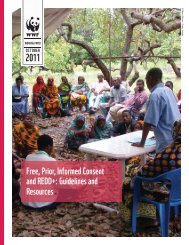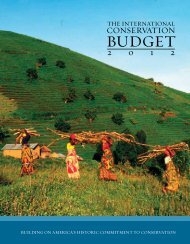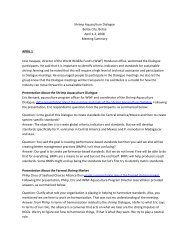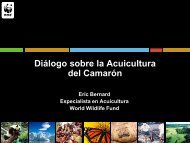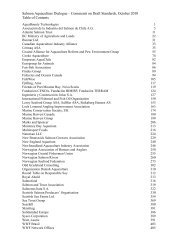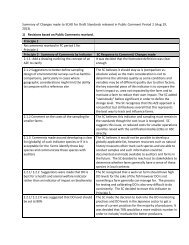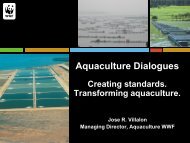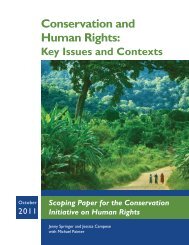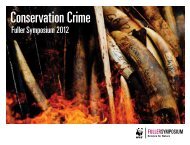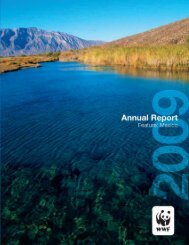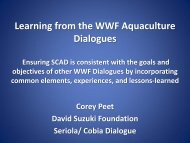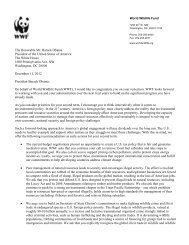Waste Management Blueprint for the Galápagos Islands
Waste Management Blueprint for the Galápagos Islands
Waste Management Blueprint for the Galápagos Islands
- No tags were found...
You also want an ePaper? Increase the reach of your titles
YUMPU automatically turns print PDFs into web optimized ePapers that Google loves.
WASTEMANAGEMENTBLUEPRINT FORTHE GALÁPAGOSISLANDSMarch 2010
WWF’s mission is to stop <strong>the</strong> degradation of <strong>the</strong> planet’s natural environment and to builda future in which humans live in harmony with nature, by:- conserving <strong>the</strong> world’s biological diversity- ensuring that <strong>the</strong> use of renewable resources is sustainable- promoting <strong>the</strong> reduction of pollution and wasteful consumption.World Wildlife FundWWF – Galápagos Program1250 Twenty-Fourth St., NW Seymour y Av. Charles DarwinWashington, DC 20037, USAPuerto Ayora, Isla Santa CruzWebsite: www.worldwildlife.orgIslas Galápagos, EcuadorTel.: 202-495-4800 Tel. & Fax: (593 5) 252-6053Fax: 202-223-6971WASTE MANAGEMENT BLUEPRINTFOR THE GALÁPAGOS ISLANDSMarch 2010Prepared by:Written by:Ulf Torsten Hardter, Ph. D.Program Officer Renewable Energies and <strong>Waste</strong> <strong>Management</strong>Galápagos Program-WWFIrma Larrea Oña, M. A.Senior Program Officer, Galápagos, WWF-USKevin M. ButtGeneral Manager, Chief Environmental / Safety OfficerToyota Motor Engineering & Manufacturing North America, Inc.Jaycie ChitwoodFuture Fuels and Environmental Strategy ManagerToyota Motor Sales, U.S.A., Inc.
WASTE MANAGEMENT BLUEPRINTFOR THE GALÁPAGOS ISLANDSMarch 2010Index1. Introduction 32. Current <strong>Waste</strong> <strong>Management</strong> Situation in <strong>the</strong> 5Galápagos <strong>Islands</strong>2.1. Main Causes of Marine Pollution in <strong>the</strong> Galápagos<strong>Islands</strong> 52.2. <strong>Waste</strong> Generation by Sectors in <strong>the</strong> Galápagos <strong>Islands</strong> 62.3. Summary of Current <strong>Waste</strong> <strong>Management</strong> Activities, 7by Island2.4. Characterization of <strong>Waste</strong> in <strong>the</strong> inhabited islands 8of Galápagos3. WWF and Toyota Activities 103.1. WWF and Toyota Activities in Santa Cruz Island, 10Galápagos3.2. Results of Activities 113.3. Lessons Learned 114. <strong>Waste</strong> <strong>Management</strong> <strong>Blueprint</strong> 125. Sustainability 145.1. Technical Sustainability 165.2. Financial Sustainability 165.3. Social Sustainability 16WASTE MANAGEMENT BLUEPRINT FOR THE GALÁPAGOS ISLANDS
WASTE MANAGEMENT BLUEPRINTFOR THE GALÁPAGOS ISLANDSMarch 2010Program Directors:Lauren Spurrier, Managing Director, Galápagos, WWF-USEliécer Cruz, Ecoregional Director, Galápagos Program - WWFEdition and production of <strong>the</strong> current publication:Irma Larrea Oña, Senior Program Officer, Galápagos, WWF-USPhoto credits. Cover: Puerto Ayora, Santa Cruz Island, Galápagos © WWF/Eunice Park.Page 1: Sally ligthfoot crabs, Galápagos <strong>Islands</strong> © WWF/Lee Poston. Page 3: Tourists inGalápagos © WWF/Lee Poston. Page 4: Junk yard in Puerto Ayora, Galápagos <strong>Islands</strong> ©WWF/Ulf Hardter. Page 5: Workers of <strong>the</strong> Recycling Center, Santa Cruz Island © WWF/LeePoston. Page 8: <strong>Waste</strong> containers at <strong>the</strong> Itabaca Canal, Santa Cruz Island, Galápagos ©WWF/Eunice Park. Page 9: Transportation of produces, Santa Cruz Island, Galápagos ©WWF/Lee Poston. Page 11: Distribution of waste containers at <strong>the</strong> commercial sector ofSanta Cruz, Galápagos © WWF/Ulf Hardter. Page 12: Truck to collect recyclable materials,Santa Cruz Island, Galápagos © WWF/Ulf Hardter. Page 15: Compost plant, Santa CruzIsland, Galápagos © WWF/Ulf Hardter. Page 16: Mural of <strong>the</strong> education campaign onrecycling practices, Santa Cruz Island, Galápagos © WWF/Enrique Ramos.Design and printing: AH/editorial© Copyright No. 033208ISBN-978-9942-02-893-8How to cite this publication: WWF and Toyota. 2010. <strong>Waste</strong> <strong>Management</strong> <strong>Blueprint</strong> <strong>for</strong> <strong>the</strong>Galápagos <strong>Islands</strong>. WWF. Puerto Ayora, Galápagos.Parts of this publication can be reproduced without previous written permission if <strong>the</strong>source is cited. For <strong>the</strong> total reproduction of this document, WWF must be previouslyin<strong>for</strong>med.Published in Quito, Ecuador by WWF © 2010.All rights reserved by WWF.Printed on recycled paper
31. IntroductionThe Galápagos <strong>Islands</strong> have achieved worldwide significance and globalrecognition because of <strong>the</strong>ir marine and terrestrial endemic uniqueness;<strong>the</strong>ir geological <strong>for</strong>mations; and because of <strong>the</strong>ir geographic location at <strong>the</strong>convergence of five important marine currents. The islands are also knownworldwide as <strong>the</strong> inspiration <strong>for</strong> Charles Darwin’s <strong>the</strong>ory of naturalselection.Key milestones in <strong>the</strong> modern history of <strong>the</strong> Galápagos include:1934 Galápagos designated a wildlife sanctuary1959 97% of its terrestrial area declared a National Park1978 Galápagos declared a World Natural Heritage Site by UNESCO1984 Galápagos declared a Biosphere Reserve by UNESCO1986 Galápagos Marine Reserve created1998 Galápagos Special Law created2001 Marine Reserve declared a UNESCO World Natural HeritageSiteThe national and internationalattention has attracted many visitors,primarily tourists andEcuadorian immigrants insearch of new employment opportunities.In <strong>the</strong> late 1960s <strong>the</strong>rewere approximately 2,000 visitorsto <strong>the</strong> islands each year; by2007, this number had increasedto more than 160,000 per year 1 .The continuous growth in tourismand its associated economicopportunity has also caused asteady growth in immigration.The current population growthis greater than 6% annually 2 . Ifthis trend continues, <strong>the</strong> populationof <strong>the</strong> islands will doublewithin 12 years.This growth in tourism and population has severely impacted <strong>the</strong> islands,including <strong>the</strong> introduction of invasive species and increased pressure on <strong>the</strong>natural resource base from agriculture and fishing. There has also been anincrease in <strong>the</strong> demand <strong>for</strong> infrastructure, goods and services. This has ledto unsustainable levels of energy and water consumption; contamination ofair, soil, and fresh and seawater resources; and public health problems,among o<strong>the</strong>rs.1. Epler Bruce (2007).“Tourism, <strong>the</strong> Economy,Population Growth andConservation in Galápagos.”Charles Darwin Foundation,Santa Cruz, Galápagos,Ecuador. 75 pp.2. WWF (2003). “Migration andEnvironment in <strong>the</strong> Galápagos<strong>Islands</strong>.” Quito, Ecuador. 135pp.WASTE MANAGEMENT BLUEPRINT FOR THE GALÁPAGOS ISLANDS
4In 2007, recognizing <strong>the</strong>se increasing pressures on <strong>the</strong> islands and <strong>the</strong>ir associatednegative impacts on <strong>the</strong> natural resource base, <strong>the</strong> Ecuadoriangovernment and UNESCO made two key decisions:April 2007 Emergency Decree issued by <strong>the</strong> President of Ecuador declaring<strong>the</strong> conservation and environmental management of <strong>the</strong>Galápagos ecosystem at risk, and declaring <strong>the</strong> islands anational priority.June 2007UNESCO placed <strong>the</strong> Galápagos <strong>Islands</strong> on its EndangeredWorld Heritage Site list.Currently, one of <strong>the</strong> most critical environmental threats to <strong>the</strong> Galápagos is<strong>the</strong> increased generation of waste and improper waste managementpractices. These threats affect not only <strong>the</strong> terrestrial areas of <strong>the</strong> inhabitedislands but also <strong>the</strong> unique ecosystems of non-inhabited islands and Galápagos’fragile marine ecosystems.WASTE MANAGEMENT BLUEPRINT FOR THE GALÁPAGOS ISLANDS
52. Current <strong>Waste</strong> <strong>Management</strong>Situation in <strong>the</strong> Galápagos <strong>Islands</strong>The management of municipalsolid waste in <strong>the</strong> Galápagos iscomplex, and has not evolved at <strong>the</strong>same pace as <strong>the</strong> islands’urbanization and economic growth.Although solid waste disposal wasidentified as an issue several yearsago, <strong>the</strong> Municipalities of <strong>the</strong> fourinhabited islands have not hadsufficient resources or localtechnical expertise to adequatelyaddress <strong>the</strong> problem to date.The waste collection and transportationsystems in <strong>the</strong> Galápagos<strong>Islands</strong> are not well-organized anddo not extend to all inhabited areas.In areas where a collection mechanism does exist, old or inadequateequipment is used, and <strong>the</strong>re are no sanitary landfills on any of <strong>the</strong> inhabitedislands <strong>for</strong> <strong>the</strong> final disposal of waste. The places <strong>for</strong> final disposal can becharacterized as dumpsites, where waste gets dumped and openly burned.In addition to household waste, <strong>the</strong> dumpsites contain chemicals and biohazardoushospital waste. These chemicals and toxic materials leach into <strong>the</strong>ground, contaminating scarce groundwater sources, and create toxic gaseswhen burned. The dumpsites attract and provide breeding ground <strong>for</strong>parasites, rats and insects and help to spread <strong>the</strong>se invasive species. Illegaldumping of waste also takes place.Litter is also a problem. This is primarily due to a lack of awareness of <strong>the</strong>population, but also due to waste dropped from waste collection trucks andlight waste blown away from open-sky dumpsites.2.1 Main Causes of Marine Pollutionin <strong>the</strong> Galápagos <strong>Islands</strong>While some of <strong>the</strong> marine pollution in <strong>the</strong> Galápagos is from litter blown tosea from <strong>the</strong> inhabited islands, <strong>the</strong> primary source is tourism ships. While itis legal <strong>for</strong> <strong>the</strong> tourism ships to dispose of <strong>the</strong>ir organic waste in <strong>the</strong> waterssurrounding <strong>the</strong> islands, plastics that are not completely separated from <strong>the</strong>organic waste also often end up in <strong>the</strong> water. These plastics include bags,bottle caps/stoppers, labels and small bottles. Finally, due to a lack of treatmentfacilities, all ships dump <strong>the</strong>ir wastewater and highly contaminatedbilge waters directly into <strong>the</strong> sea.WASTE MANAGEMENT BLUEPRINT FOR THE GALÁPAGOS ISLANDS
6Small fishing boats that dump fishing lines and nets overboard, ra<strong>the</strong>r thandisposing of <strong>the</strong>m on land, are ano<strong>the</strong>r source of marine pollution. Thesenets can become deadly traps <strong>for</strong> sea birds, mammals and turtles.2.2 <strong>Waste</strong> Generation by Sectorsin <strong>the</strong> Galápagos <strong>Islands</strong>Table 1<strong>Waste</strong> Generation by Sectors in <strong>the</strong> Galápagos <strong>Islands</strong>Sector Santa Cruz Island San Cristobal Island Isabela Island(including Baltra Island) (including Floreana Island)<strong>Waste</strong> 16,000 inhabitants 8,000 inhabitants 3,000 inhabitantsGeneration About 10 tons/day About 6,4 tons/day About 2,4 tons/dayHouseholds Recyclables, Organics, Non-Recyclables. Recyclables, Organics,Major Producer of Non-Recyclables,Non-Recyclables.Scraps and Special <strong>Waste</strong>.Major Producer of <strong>Waste</strong>.Commercial Major Producer of Recyclables. Major Producer of Recyclables.Bars and Restaurants Big Producer of Recyclables and Organics. Producer of Recyclables and Organics.Tourism: Hotels Big Producer of Recyclables and Organics. Big Producer of Recyclablesand Organics.Tourism: Ships and Boats Major Producer 3 rd largest Producer No detailed in<strong>for</strong>mation.of <strong>Waste</strong> Oil.of <strong>Waste</strong> Oil.Electric Power 2 nd largest Producer Major Producer of <strong>Waste</strong> Oil. Major Producer of <strong>Waste</strong> Oil.of <strong>Waste</strong> Oil. Producer of Special and Producer of SpecialProducer of Special and Toxic <strong>Waste</strong> (PCB’s). and Toxic <strong>Waste</strong> (PCB’s).Toxic <strong>Waste</strong> (PCB’s).Transport 3 rd largest Producer 2 nd largest Producer No detailed in<strong>for</strong>mation but significant.of <strong>Waste</strong> Oil.of <strong>Waste</strong> Oil.Fishing<strong>Waste</strong> Oil and Sea Debris.Handcraft and Big Producer of Scraps, Toxic and Special <strong>Waste</strong>. No detailed in<strong>for</strong>mation available.Semi-IndustrialHospitals, Hospital <strong>Waste</strong>, Bio-hazardous <strong>Waste</strong>, Drugs. No detailed in<strong>for</strong>mation available.Medical Assistanceand PharmaciesAgriculture Producer of Special Organic <strong>Waste</strong>. No detailed in<strong>for</strong>mation available.Source: Environmental Department of <strong>the</strong> Municipality of Santa Cruz, Galápagos 2008.WASTE MANAGEMENT BLUEPRINT FOR THE GALÁPAGOS ISLANDS
72.3 Summary of Current <strong>Waste</strong> <strong>Management</strong> Activities, by islandTable 2Summary of Current <strong>Waste</strong> <strong>Management</strong> Activities, by island<strong>Waste</strong> CollectionFinal <strong>Waste</strong>TreatmentReciclajeScrap Metaland Used TiresHospital andBio-hazardous <strong>Waste</strong>Special <strong>Waste</strong>(Computers,Cell phones,Air Conditioners, etc.)Toxic <strong>Waste</strong><strong>Waste</strong> Oil CollectionEnvironmentalEducation Campaignon Recycling PracticesMonitoring andControl SystemMunicipal Ordinanceon <strong>Waste</strong><strong>Management</strong> andRecyclingStreetCleaning/Sweeping/LitterIsla Santa Cruz(including Baltra Island)Separated, 100% coverage.No Sanitary Landfill.Basic management of dumpsite.Recycling System since 2006.Estimated Efficiency (2008):- Non-Recyclables: 10m 3 -12m 3 /day- Recyclables: 10m 3 /day- Organics: 1m-2m 3 /dayBasic Scrap <strong>Management</strong> System- Separated Collection- Primitive Scrap yard- Exportation of scrap metal andused tires to <strong>the</strong> mainlandSeparated and weekly collectionof Hospital and Bio-hazardous<strong>Waste</strong>.Incineration in special incinerator.Oil Collection System since2000 (RELUGAL).No Collection of Oil Filters, BrakeFluids, Cooking Oil.Continuous Environmental EducationCampaigns on Recycling Practicessince 2007.Continuous Monitoring and Controlof <strong>Waste</strong> Separation.Continuous Monitoring and Controlof <strong>Waste</strong> Separation.Existent, has to be revised andimproved.Municipal Street Cleaning Systemexistent. Has to be improved.Lack of basic equipment: Publicdustbins, efficient equipment <strong>for</strong>street cleaning.Environmental Campaign on Not-Littering is missing.San Cristobal Island(including Floreana Island)Separated, 90% coverage.Recycling System since 2007.Efficiency: No in<strong>for</strong>mation available.Estimation: less than 10%in weight.No reliable in<strong>for</strong>mation availableIncinerator existing.Oil Collection System since 2007(RELUSAN).No Collection of Oil Filters, BrakeFluids, Cooking Oil.Sporadic Environmental EducationCampaigns on Recycling Practicessince 2007.Sporadic Monitoring and Control of<strong>Waste</strong> Collection System.Continuous Monitoring and Controlof <strong>Waste</strong> Separation.Existent, has to be revised andimproved.Municipal Street Cleaning Systemexistent. Has to be improved.Lack of basic equipment: Publicdustbins, efficient equipment <strong>for</strong>street cleaning.Environmental Campaign on Not-Littering is missing.No Sanitary Landfill.Open-sky dumpsite.Isabela IslandNot separated. No detailedin<strong>for</strong>mation availableNo Recycling System.No Scrap <strong>Management</strong> System.Scraps and used tires get dumped at <strong>the</strong> dumpsite.No Separation, No Collection, No Treatment.No Separation, No Collection, No Treatment.No collection of hospitaland bio-hazardous waste.No incinerator.No Oil Collection System.No Collection of Oil Filters,Brake Fluids, Cooking Oil.No Environmental EducationCampaigns on RecyclingPractices.No Monitoring and Control.Non existent.Municipal Street CleaningSystem existent.Lack of basic equipment:Public dustbins.Environmental Campaign onNot-Littering is missing.WASTE MANAGEMENT BLUEPRINT FOR THE GALÁPAGOS ISLANDS
82.4 Characterization of <strong>Waste</strong> in <strong>the</strong>inhabited islands of GalápagosA study carried out by WWF in 2008 3 shows that, currently, waste in <strong>the</strong>Galápagos <strong>Islands</strong> is mainly composed of organic materials. In Santa CruzIsland, approximately 40% of all collected waste is organic. This is low incomparison to cities in mainland Ecuador, where <strong>the</strong> organic materialcomprises 50%-60% of total waste collected. The reason <strong>for</strong> this may be thatmany products arrive in Galápagos semi-processed or clean, <strong>the</strong>rebyreducing <strong>the</strong> volume of food scraps <strong>for</strong> disposal, and also that much of <strong>the</strong>organic waste that is produced, such as leaves, fruit, and vegetable skins, isused to feed animals (e.g. pigs). In contrast, non-organic waste hascomparatively high collected amounts compared to mainland Ecuador,including cardboard (6.83% of total collected waste), glass (7.85%), plastic(2.8%) and disposable baby diapers (5%).The results <strong>for</strong> San Cristobal and Isabela <strong>Islands</strong> differ from those <strong>for</strong> SantaCruz Island. For example, in San Cristobal Island, organic materials account<strong>for</strong> 61%, cardboard 6.23%, glass 5.8% and plastic 3.53%; while in Isabela Islandorganic materials comprise 85.71%, cardboard 1.36%, glass 2.59% andplastic 2.99%.Projections showed that every ten years <strong>the</strong> amount of waste generated inGalápagos doubles. This is not only due to population growth but to newand increased consumption patterns.These data will help to in<strong>for</strong>m <strong>the</strong> Municipalities of <strong>the</strong> three islands as <strong>the</strong>ylook to create sustainable, long-term waste management practices and systems.3. De la Torre, Francisco(2008) “Characterization ofSolid <strong>Waste</strong> in Santa Cruz,San Cristobal and Isabela,Galápagos.” Internal WWFReport.WASTE MANAGEMENT BLUEPRINT FOR THE GALÁPAGOS ISLANDS
9Table 3Household <strong>Waste</strong> Produced in <strong>the</strong> Galápagos <strong>Islands</strong>Amount producedISLANDSSanta Cruz San Cristobal IsabelaProducción per cápita 0.617 0.559 0.598Kg/person/day Kg/person/day Kg/person/daySolid waste total 11.21 tons/day 4.17 tons/day 1.43 tons/dayCommercial 26 % 20 % 15 %Residential 58 % 67 % 73 %Rural 16 % 13 % 12 %TOTAL 100% 100% 100%Source: De la Torre, Francisco (2008) “Characterization of Solid <strong>Waste</strong> in Santa Cruz, San Cristobal and Isabela <strong>Islands</strong>, Galápagos,” Internal WWF Report.Table 4<strong>Waste</strong> Produced on Tourism Boats and Disposed on Santa Cruz, San Cristobal and Isabela <strong>Islands</strong>Amount producedISLANDSSanta Cruz San Cristobal IsabelaTotal barcos de turismo 2.1 tons/day 0.8 tons/day 0.3 tons/daySource: De la Torre, Francisco (2008) “Characterization of Solid <strong>Waste</strong> in Santa Cruz, San Cristobal and Isabela <strong>Islands</strong>, Galápagos,” Internal WWF Report.WASTE MANAGEMENT BLUEPRINT FOR THE GALÁPAGOS ISLANDS
103. WWF and Toyota ActivitiesThe first <strong>for</strong>mal recycling ef<strong>for</strong>t in Galápagos started in Santa Cruz Island in<strong>the</strong> late 1990s, supported by <strong>the</strong> Galápagos National Park Service, <strong>the</strong> GalápagosFoundation and <strong>the</strong> Municipality. Since that time <strong>the</strong> Galápagos Foundationhas provided ongoing funding <strong>for</strong> <strong>the</strong> staffing and administration of<strong>the</strong> Municipal recycling center. Between 2003 and 2006, with funding from<strong>the</strong> European Union (URB-AL-Program), <strong>the</strong> Municipality built a recyclingplant and a compost area, purchased a waste compactor truck, and hired aconsultant <strong>for</strong> <strong>the</strong> Municipality of Santa Cruz to coordinate <strong>the</strong> project’slaunch and implementation.Having worked toge<strong>the</strong>r on conservation issues in <strong>the</strong> Galápagos <strong>for</strong> severalyears, in 2006 WWF and Toyota began to focus on <strong>the</strong> critically importantarea of waste management. The work built upon <strong>the</strong> ef<strong>for</strong>ts already startedby <strong>the</strong> Municipality of Santa Cruz. We chose to focus on Santa Cruz because<strong>the</strong>re was already an existing structure to work with, and because 60% of<strong>the</strong> waste generated in <strong>the</strong> archipelago is generated on Santa Cruz. One of<strong>the</strong> first activities was to improve <strong>the</strong> waste collection system by requiringhouseholds to separate waste into three categories: recyclables, organics andnon-recyclables. O<strong>the</strong>r activities are detailed below.3.1 WWF and Toyota Activitiesin Santa Cruz Island, GalápagosRecyclingExpanded <strong>the</strong> existing recycling centerDonated a mechanical composter (to process <strong>the</strong> larger volume o<strong>for</strong>ganic waste)Created <strong>the</strong> Municipal Environmental Department to serve as programcoordinatorDonated 7,500 colored containers <strong>for</strong> waste separation (3 perhousehold)Funded and assigned an international environmental expert to <strong>the</strong>Municipality of Santa Cruz to manage <strong>the</strong> recycling programFunded and assigned a local expert to <strong>the</strong> Municipality of Santa Cruzto assess and manage <strong>the</strong> programFunded and implemented a 3-year education and outreach campaignon recycling practicesSupported <strong>the</strong> oil recycling projects RELUGAL in Santa Cruz Islandand RELUSAN in San Cristobal Island (including training, donation ofequipment, infrastructure and technical assessment, and funding ofoperating costs)Funded <strong>the</strong> design and <strong>the</strong> environmental impact assessment of <strong>the</strong> sanitarylandfillWASTE MANAGEMENT BLUEPRINT FOR THE GALÁPAGOS ISLANDS
11<strong>Waste</strong> Collection Replaced existing waste compactor truck Donated a truck scale to weigh <strong>the</strong> waste streams Expanded service to rural inhabited areas Expanded service to tourism boats Installed GPS-monitoring of <strong>the</strong> collection trucks Redesigned street-cleaning service to reduce litter Implemented a continuous monitoring program in combination withzoning of <strong>the</strong> urban areas Held training workshops <strong>for</strong> <strong>the</strong> Municipal street cleaning team3.2 Results of Activities• 260% increase in waste recycledbetween January 2007 andAugust 2009.• 35% reduction in per-capitawaste generation (from 0.62kg/person/day to 0.4 kg/person/day)between January2007 and August 2009.• 400% increase in compostingand recycling system efficiencybetween January 2007and August 2009.3.3 Lessons Learneda) Assuring <strong>the</strong> long term conservation of <strong>the</strong> Galápagos is only possibleby involving <strong>the</strong> local population - creating <strong>the</strong> political will andcommitment of <strong>the</strong> local decision-makers and stakeholders, and <strong>the</strong>neducating and engaging <strong>the</strong> community.b) It is critical to build local knowledge, expertise and capacity. This wasachieved by providing technical assistance and training to localtechnicians by temporarily integrating technical experts into localinstitutions.c) Success is measured over a period of years, and in increments.d) There is a need <strong>for</strong> on-going community education, as 1) <strong>the</strong> concept ofwaste classification is still very new; and 2) <strong>the</strong> population continues togrow.WASTE MANAGEMENT BLUEPRINT FOR THE GALÁPAGOS ISLANDS
124. <strong>Waste</strong> <strong>Management</strong> <strong>Blueprint</strong>WWF and Toyota’s vision is that by<strong>the</strong> year 2020, an integrated wastemanagement and recycling systemwill be implemented on all inhabitedislands of Galápagos. The system willensure an efficient and completecollection of all waste types, withsignificant reductions in <strong>the</strong> quantitiesof waste generated through effectivewaste minimization programs,including elimination of waste at <strong>the</strong>source, improvement of currentrecycling activities, and <strong>the</strong>development of recycling, disposaland treatment options <strong>for</strong> o<strong>the</strong>r typesof waste.The mission of this waste management blueprint <strong>for</strong> <strong>the</strong> Galápagos <strong>Islands</strong>is to achieve significant progress toward <strong>the</strong> 2020 vision, by:• Raising awareness at <strong>the</strong> community, government and political levelsabout <strong>the</strong> need <strong>for</strong> proper waste management in <strong>the</strong> Galápagos <strong>Islands</strong>.• Significantly reducing <strong>the</strong> quantities of waste generated, particularlywaste that needs to be treated and disposed in sanitary landfills.• Upgrading current waste collection and disposal systems.• Addressing <strong>the</strong> current financial, regulatory, institutional and socialbarriers to effective waste management in <strong>the</strong> Galápagos.• Reducing <strong>the</strong> potential <strong>for</strong> adverse environmental and health impactsfrom on-going waste collection and disposal activities.• Establishing permanent waste management positions at <strong>the</strong> threeMunicipalities, and training <strong>the</strong>se personnel.• Establishing financial, regulatory and o<strong>the</strong>r relevant mechanismswithin each Municipality to ensure effective and sustainable integratedwaste management <strong>for</strong> <strong>the</strong> Archipelago.• Educating <strong>the</strong> local populations about <strong>the</strong> need <strong>for</strong> and methods ofproper waste management.WASTE MANAGEMENT BLUEPRINT FOR THE GALÁPAGOS ISLANDS
13Table 5Short Term Actions (~2010 – 2013)Detailed Analysis of <strong>Waste</strong>Production and <strong>Waste</strong> CompositionSanta Cruz Island San Cristobal Island Isabela Island(including Baltra Island) (incl. Floreana Island)Recyclables, Organics, Non-Recyclables,Scraps, Special <strong>Waste</strong>, Toxic <strong>Waste</strong>, <strong>Waste</strong> Oil2010 – 2011Final <strong>Waste</strong> Treatment/Design and Environmental Impact AssessmentSanitary Landfill 2010 – 2013<strong>Waste</strong> CollectionPurchase and Donation of a <strong>Waste</strong>Compactor Truck and a Truck ScaleCompleted in 2008.Completed 2013. To be analyzed.RecyclingImprovement of <strong>the</strong> RecyclingCentre by 2011.Improvement of <strong>the</strong>Recycling Centre by 2013.Design and Constructionof a Recycling Centre2010 - 2013.<strong>Waste</strong> Oil CollectionImprovement of <strong>the</strong> ExistingSystem by 2010.Improvement of <strong>the</strong>Existing System by 2010.To be analyzed.Environmental Education Campaignon Recycling PracticesContinue existing campaign onrecycling practices.Create and Augment existingcampaign with in<strong>for</strong>mation onavoiding waste and litter.To be analyzed.Hospital and Biohazardous <strong>Waste</strong> Improve <strong>the</strong> existing system by2012.Improve <strong>the</strong> existingsystem by 2012.To be analyzed.Transportation Improvement and Urgent. To be analyzed.Extension of Sea Transport Capacity <strong>for</strong>Recyclables, Scraps, Used Tires, etc.Table 6Mid Term Actions (~2014 – 2016)Santa Cruz Island San Cristobal Island Isabela Island(including Baltra Island) (incl. Floreana Island)Final <strong>Waste</strong> Treatment/ Construction and Operation Construction and Operation Construction andSanitary Landfill 2014 - 2016 2014 - 2016 Operation.2014 - 2016Scrap Metals, Used Tiresand Special <strong>Waste</strong>Toxic <strong>Waste</strong>Design and Constructionof a Centre <strong>for</strong> Scrap Metals,Used Tires and Special <strong>Waste</strong>2014 - 2015Design and Construction of a Toxic<strong>Waste</strong> Treatment System2014To be analyzed.To be analyzed.Institutional Streng<strong>the</strong>ning Periodic Assessment. To be analyzed. Implementation of aMunicipal EnvironmentalDepartment.Monitoring and ControlPeriodic Assessment onEnvironmental Regulations.To be analyzed.Municipal Ordinance on <strong>Waste</strong> To be improved by 2014. To be improved by 2014. Established by 2014.<strong>Management</strong> and RecyclingStreet Cleaning/Sweeping/LitterTo be analyzed.Including avoid Sea Debris/LitterWASTE MANAGEMENT BLUEPRINT FOR THE GALÁPAGOS ISLANDS
14Long Term Actions (~2017 – 2020)• Establish inter-municipal waste and recycling cooperation.• Establish a provincial ordinance on waste management and recycling.• Establish a common transportation and commercialization system <strong>for</strong>recyclables, metal scraps, used tires, etc.• Establish a common environmental education campaign on wastemanagement and recycling.• Establish a common waste management and recycling systemincluding waste oil collection and recycling.• Reduce <strong>the</strong> volume of waste generated per person.With this blueprint, we have identified <strong>the</strong> most significant steps that needto be addressed in order to put <strong>the</strong> waste management systems in <strong>the</strong>Galápagos on more sustainable footing. However, we recognize that <strong>the</strong>scope of this task is beyond anything one or two organizations might be ableto achieve, and that any successful ef<strong>for</strong>t will require <strong>the</strong> full assistance andparticipation of a wide range of stakeholders.5. SustainabilityThe goals and actions of this waste management blueprint are based on <strong>the</strong>proven/commonly accepted principles and strategies of sustainable wastemanagement. Using <strong>the</strong>se, we aim to implement an integrated wastemanagement and recycling system by <strong>the</strong> year 2020, which will improve <strong>the</strong>quality of human life on all inhabited islands of Galápagos while livingwithin <strong>the</strong> carrying capacity of <strong>the</strong> supporting insular eco-systems.Our concept of a sustainable waste management and recycling system in <strong>the</strong>Galápagos is based on strategies and principles mentioned below.<strong>Waste</strong> Minimization: <strong>Waste</strong> minimization is <strong>the</strong> process and <strong>the</strong> policy ofreducing <strong>the</strong> amount of waste produced by a person or a society and is <strong>the</strong>basis of any sustainable waste management system. <strong>Waste</strong> minimization isaimed at reducing <strong>the</strong> generation of waste through education and improvedconsumption patterns. This approach is <strong>the</strong> most economical,environmentally friendly and sustainable method of waste management butalso represents <strong>the</strong> toughest challenges. It requires changes in <strong>the</strong> localconsumption patterns, paradigms and behavior on <strong>the</strong> part of <strong>the</strong>population and decision-makers as well as political will and commitment.This can only be achieved through long-term environmental campaigns andinstitutional streng<strong>the</strong>ning and can be combined with a culture of hygiene,public health and quality of life.WASTE MANAGEMENT BLUEPRINT FOR THE GALÁPAGOS ISLANDS
165.1 Technical SustainabilityIt is essential to build technical capacity and proficiency in local institutionsin <strong>the</strong> operation and management of a modern waste management andrecycling system by providing continuous technical assistance onsite.Several initiatives and projects have shown that transferring technology andconcepts alone is not sufficient and must be combined with continuoustraining and technical assistance. Our experience in Santa Cruz Islanddemonstrates that sustained technical assistance within <strong>the</strong> existingmunicipal structure can create lasting and transferable local knowledge.Working within existing structures allows <strong>for</strong> flexibility to adapt <strong>the</strong>implementation of modern waste management and recycling systems to <strong>the</strong>local realities.It also provides an opportunity <strong>for</strong> local authorities and <strong>the</strong> population tolearn and recognize <strong>the</strong> benefits provided by <strong>the</strong> new initiative. Thesebenefits do not come up immediately with <strong>the</strong> project’s implementation butneed time to arise and to get recognized.5.2 Financial SustainabilityCreating financial sustainability of a waste management systemin <strong>the</strong> Galápagos is challenging, and probably will be notpossible in <strong>the</strong> near-to-mid term. Commercializing recycledmaterial alone can contribute, but is insufficient by itself.However, <strong>the</strong>re are promising instruments <strong>for</strong> creating sufficientrevenue to cover <strong>the</strong> operational costs of a waste managementsystem and urge/stimulate <strong>the</strong> consumers to change <strong>the</strong>ir habitsto a more sustainable attitude.The Polluter Pays Principle requires that waste producersassume <strong>the</strong> costs <strong>for</strong> waste processing and management. It alsorequires those who pollute <strong>the</strong> environment (e.g. by littering orfly-tipping) to be responsible <strong>for</strong> <strong>the</strong>ir actions.The Extended Producer Responsibility requires <strong>the</strong> producer orano<strong>the</strong>r entity along <strong>the</strong> value chain of a product to beresponsible <strong>for</strong> <strong>the</strong> product’s end-of-life and includes also itspackage.5.3 Social SustainabilityAno<strong>the</strong>r critical component in ensuring <strong>the</strong> sustainability of proper wastemanagement is <strong>the</strong> cooperation of <strong>the</strong> local population. A long termenvironmental education campaign which focuses on <strong>the</strong> preventionprinciple as a fundamental notion will be expanded beyond recyclingpractices and reduction of waste as <strong>the</strong> main tool to achieve a new culture<strong>for</strong> sustainable waste management and recycling.WASTE MANAGEMENT BLUEPRINT FOR THE GALÁPAGOS ISLANDS



